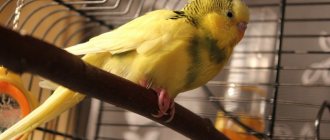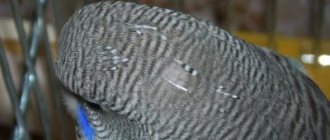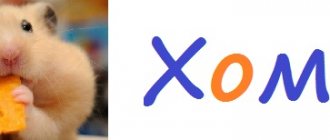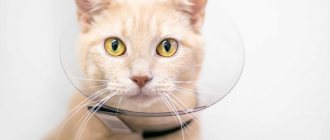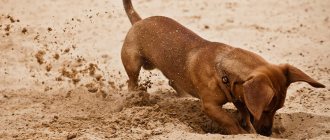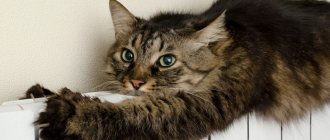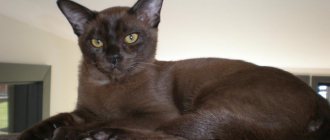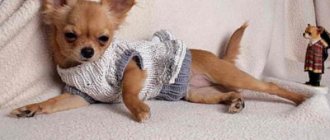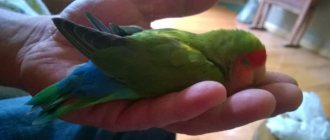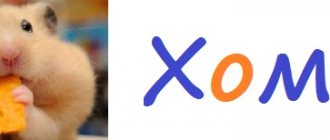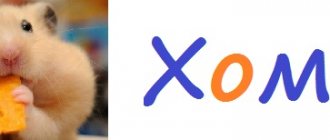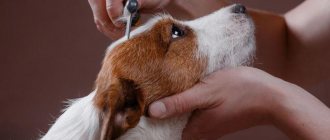Shedding in cockatiels is a common occurrence that occurs in all parrots at one time or another. However, for inexperienced owners it often causes fear and concern for the health of their pet. In most cases, cockatiels' feathers fall out due to natural reasons, but it happens that this process occurs due to illness. Let's talk about when cockatiel parrots begin to molt, how you can help your pet during this difficult period for him, about the natural and pathological reasons for the change in plumage.
At what age does a cockatiel begin to shed?
Corella parrots are born with soft and thick yellow down. After some time, the birds begin to naturally molt, after which “adult”, more colorful and brighter plumage appears. Experienced ornithologists are able to determine the male and female by its color and saturation.
First (juvenile)
The first molt (also called juvenile) in a cockatiel begins at approximately 4 to 6 months of age. She says that the chicks are already fully mature and will eventually be ready to give birth to new offspring. The thin downy cover is replaced by stronger feathers, which not only better protect the body, but also enable the bird to fly. Molting is one of the most natural processes in the animal world that occurs with young animals, and not only with cockatiels.
Depending on the diet and living conditions, the cockatiel may begin to shed earlier or later. If a bird aged 6 months or older does not change its plumage, this indicates health problems.
Attention! Complete renewal of plumage during juvenile molting occurs by 12 months. From this moment on, the cockatiel is considered sexually mature and can have offspring.
Periodic
Subsequent molts of parrots are called periodic; they are associated with the seasons of the year and the nesting period. If a cockatiel lives alone, it loses old feathers once a year (sometimes 2 times), from September to December. This type of molting in Corella parrots lasts 1 month. During this time, the old feathers are completely replaced with new ones.
If a pair of cockatiels are in mating season, they may begin to molt immediately after mating or some time later when the female lays eggs.
Important! During the molting period, the cockatiel can become aggressive because the process of sprouting new feathers causes discomfort, irritating the pet's skin. Some, on the contrary, become drowsy and lethargic, as they try to sleep more at this time, but they do not always succeed.
Therefore, during such a period, the owner needs to be especially attentive and patient with the parrot.
Diseases caused by mites and fungi
Why does a parrot lose feathers on its head, body and tail? This may indicate the presence of a fungal disease or exposure to disease-causing mites on the skin. At the same time, the parrot's plumage begins to fall out very much, and completely bare areas of the body appear. The general condition of the pet often worsens. It is worth noting that a fungus or mite, once it gets on the skin of a bird, takes root almost immediately.
To make sure that the disease is present, you should carefully examine the tips of the shafts of those feathers that have already fallen out. If there are small holes or blood left on them, then the pet has become infected. Crusts, plaques and wounds may also appear on the skin, and peeling often occurs. When examining, special attention should be paid to the paws, wax and beak.
If you have found the answer to the question of why your parrot's feathers are falling out, then you should immediately seek help from a veterinarian. The bird will not be able to get rid of such a disease on its own. Usually special ointments are prescribed. The course of therapy can last more than 30 days. Such a disease should not be left untreated, as a relapse is possible.
How does plumage change?
The process of natural molting in cockatiels is different from the process of feather loss due to illness. When a cockatiel molts, pay attention to how it happens:
- With the natural change of plumage, large feathers (tail feathers, flight feathers) fall out gradually - this is necessary so that the bird does not lose the ability to fly. It is the large feathers that lift the bird into the air. The pet will fly, although you will notice that its flights will become more abrupt during this period. This speed helps old feathers fall out faster;
- the tail plumage falls out gradually, being renewed from the periphery to the center. Wing feathers, being renewed, fall out in pairs once a week;
- small feathers covering the entire body fall out haphazardly and chaotically. This plumage maintains body temperature and protects against hypothermia. When cockatiels molt, spending most of their time in a cage, they can lose almost half of their plumage in a day.
Caring for a parrot during the molting period
When cockatiel parrots begin molting, the bird spends not only a lot of energy, but also useful substances. Therefore, it is important during this period to provide the feathered pet with optimal living conditions and a diet enriched with vitamins and minerals.
Diet
Human hair and bird feathers are made of the same substance - keratin. Imagine how varied and rich in nutrients a cockatiel’s diet must be so that it can completely change its plumage in a month.
In this table you can see what a cockatiel's diet should be when molting:
| Food Ingredients | Products |
| Vegetables | Zucchini, carrots, cabbage, pumpkin |
| Greenery | Spinach, oat and wheat sprouts, dandelion and plantain leaves, carrot and beet tops, young branches and shoots of fruit trees |
| Fruits, berries | Apples, cherries, raspberries, bananas, grapes, cherries, strawberries |
| Protein products | Low-fat cottage cheese, chicken eggs |
| Mineral supplements | Crushed eggshells, chalk, sepia, bone meal, mineral stone, sand, limestone, crushed calcium gluconate tablets (1 piece per day) |
| Animal feed | Mealworms, bloodworms, grasshoppers, other insects |
| Vitamins | "Beaphar Mauser Tropfen", "Beaphar Vinka", "Vitacraft", "Vita-Sol Multi Vitamins", brewer's yeast, Rio grain mixture |
A chamomile decoction will relieve itching where new feathers appear. You need to pour 1 tbsp. of this herb with a glass of boiling water, cool to room temperature and spray it from time to time on the bald spots on the body of the cockatiel parrot.
Watch this video about what a cockatiel eats during molting:
Conditions of detention
Caring for your cockatiel during the molting period should also change. The state and mood of the bird changes at this time, so you need to adhere to the following rules:
- A young cockatiel that has undergone a juvenile molt should not be released from the cage for some time, as due to unusual changes in plumage, it may not be able to cope with the flight and fall, severely injuring itself. If the pet is an adult, on the contrary, it is worth letting him out of the cage more often - this will give him the opportunity to distract himself from unpleasant sensations and make it easier for the old feathers to fall out.
- Considering how long it takes for cockatiels to molt, water procedures in the shower can speed up the change of plumage. Bathing in a bath that can be installed directly in the cage is a good way to relieve itching from the skin. True, this option is not suitable for those cockatiels that are especially aggressive during the molting period. They can spill water from the bathing suit and create a lot of litter around.
- Bald patches that appear on the body of a parrot are not able to protect it from cold and temperature changes, therefore it is important at this time to maintain a comfortable microclimate in the room: air temperature + 20-25 ° C, humidity 60-70%.
Causes of unnatural feather loss
The Corella parrot does not always lose feathers for natural reasons. Any change in microclimate, stressful situation, unbalanced diet, regardless of the period of the year, can cause this phenomenon. Not to mention the health problem. It is important at first to distinguish between juvenile or periodic molting and pathological molting.
If there is a deficiency of minerals and vitamins, the parrot's body is not able to produce keratin in sufficient quantities to restore the feather cover, so the bird may remain bald. Changing your diet quickly solves this problem. Things are worse with other factors.
Tumors, liver or kidney diseases, hormonal imbalance, problems with the absorption of vitamins A and D in the intestines - this is a list of some of the causes of pathological molting. On the body and wings of the bird you can notice a large number of bald areas and unopened feather tubes. The bird looks plucked, unkempt, depressed, constantly itching and pecking itself. To determine the exact cause of this condition, you need to consult a veterinarian.
Stress
Due to stress, unnatural molting occurs most often in Corella parrots. By losing their plumage, birds can react to any change in their usual environment:
- change of place of residence;
- change in conditions of detention;
- monotonous nutrition and even just a change of food;
- loud noise and sharp sounds;
- bright light;
- the appearance of a new family member or his absence;
- the arrival of a new pet;
- feeling of loneliness;
- indifference or aggression on the part of the owners.
Prolonged exposure to any of these factors leads to pathological molting. Feather loss can only be treated by eliminating the irritant.
Clear signs of shock molting in a cockatiel are the sudden and dramatic loss of hair on the parrot's tail, while the rest of the plumage remains intact. The bird becomes shy, may be apathetic or, conversely, aggressive. Often refuses usual games, food and even favorite treats.
To help your pet in this situation, it is not necessary to see a doctor. Provide your parrot with a calm environment and improve its nutrition with vitamins and minerals. Considering that in a stressful situation a bird’s body temperature drops so that it does not catch a cold, provide it with heating with an incandescent lamp, placing it half a meter near the cage.
Skin diseases
Often the cockatiel plucks its feathers itself due to dermatological diseases (mycoses, dermatoses, dermatitis). A deficiency of nutrients, factors that irritate the skin, dry air in the room, and stressful situations can cause such problems.
The cockatiel becomes restless, sits, ruffled, at the bottom of the cage or perch, itches all the time and plucks its feathers. Severe itching is caused by scratching on the body, wounds, and bald areas. The skin looks painful and inflamed. Neglected conditions lead to complete baldness of the parrot on the tail and wings.
Mite or fungus
It is not uncommon for a budgerigar's feathers to fall out due to the presence of a fungus or mite. Carefully inspect the condition of the fallen feathers. In these two cases, you can see small holes or even blood on the feathers. Scabs, ulcers, and peeling appear on the skin. The budgerigar is actively itching and plucking feathers.
You can determine the presence of a tick by placing white paper or cloth on the bottom of the cage overnight. The presence of black dots or rods indicates parasites. Only a veterinarian can diagnose fungus. During treatment, the specialist prescribes combing and application of a spray. Don't forget to thoroughly disinfect the cage.
